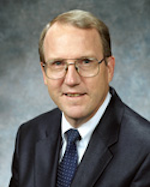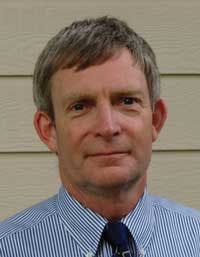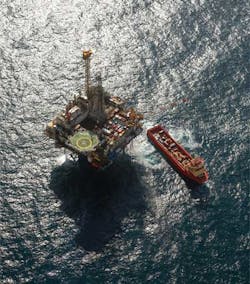Broadband acquisition, processing improving marine seismic surveys
Refinements to marine seismic work through broadband acquisition and processing are improving the precision of geophysical interpretation and the imaging of deep features. The incoming president of the Society of Exploration Geophysicists says they all involve sampling sonic energy in more ways than one.
Emerging in just the past couple of years, the refinements address a problem known as ghosting, explains David Monk, director of geophysics at Apache Corp. Survey-design adjustments to moderate ghosting, which creates false indications of subsurface reflections, result in the loss of low frequencies in the spectrum of seismic data. Because low frequencies survive the natural filtering that occurs as sound propagates through the earth, their importance grows as a function of depth. Their presence in recorded data also enhances the precision of imaging, inversion, and ultimately interpretation of the data.
The ability to "recover all of those frequencies which we typically don't get," Monk says, provides "a much better understanding of the subsurface geology." He adds, "If you're looking deep in the earth you really want the lowest frequencies you can get."
Ghosting results from reflections of seismic energy—sound—from the sea surface. In basic marine surveys, hydrophones in streamers towed underwater behind seismic vessels record energy reflected by boundaries between two layers of contrasting density and sound velocity. Desirable reflections come from the subsurface, propagate back upwards, and are recorded by hydrophones. But hydrophones also record the downward-moving energy reflected from the sea surface, a strong reflector. Because hydrophones can't determine the direction of movement of the pressure waves they record, seismic records display downward-traveling reflections from the sea surface as though they are upward-traveling reflections from below the seabed. These erroneous displays are "ghosts."
To worsen matters, downward-traveling reflections from the sea surface interfere with upward-traveling reflections from the subsurface in ways that cancel frequencies, creating "ghost notches" in the frequency spectrum. Traditionally, survey designers have set tow depths of streamers so as to minimize the effects of ghost notches at higher seismic frequencies. But they do so at the cost of lost low frequencies and the deterioration in quality of lower frequencies in the surviving range.
Distinguishing unwanted reflections
To distinguish unwanted sea-surface reflections from desirable reflections from the subsurface, new methods employ the duality of sampling highlighted by Monk, who becomes SEG president at the group's annual meeting this week in Las Vegas.
"If you can sample energy in two different ways, it helps you differentiate the energy coming up from the energy coming down from the sea surface," he explains.
Sampling pairs can be pressure and velocity or pressure and acceleration. Other approaches are to measure pressure at two depths or pressure at variable depths. Yet another approach is to record the energy in both a hydrophone and a geophone.
But those adaptations address ghosting at only one end of the seismic acquisition system.
"Once you've solved all this for the receiver," Monk says, "you've got to solve it for the source." A response to source ghosts is the generation of energy at two different depths. "It's trying to generate two separate wavefields which you then can distinguish," he says, noting that techniques for doing so are only beginning to become commercial.
Some of the emerging broadband acquisition methods offer side benefits. For example, streamers containing both hydrophones and geophones can be towed deeper than normal—at 30 m rather than 6-7 m—which can extend the survey season in areas with harsh environments such as the North Sea.
Apache also has been experimenting with simultaneous-source acquisition, which can acquire more data in a given time than traditional acquisition using sequential shots. New processing methods allow separation of the overlapping data, which can help make the crucial distinction between subsurface and sea-surface reflections. The data-acquisition efficiency makes the method a relatively inexpensive design for wide-azimuth marine surveys, which use broad source deployments to sample more of the wavefield than is possible in conventional surveys.
Monk points out that simultaneous-source acquisition is common in onshore seismic surveys using multiple vibrators. "It's been talked about offshore but never really become a commercial reality," he says. He expects "a lot more simultaneous-source work in the next few years."
Nodes and reprocessing
Monk also is interested in surveys that acquire seismic data with ocean-bottom nodes, autonomous recording instruments not connected to a central system. Nodes are especially useful where streamers are impractical, such as areas with high currents or heavy concentrations of platforms.
Because nodes collect data continuously, they well accommodate passive seismic, also called microseismic, surveys, which record energy created either by natural seismic events in the subsurface or by induced seismic events rather than reflections from a surface source. Microseismic surveys can help in reservoir monitoring and the mapping of fractures in hydraulic fracturing.
A disadvantage of node work is the preclusion of real-time availability of data. And the method historically has been expensive. But the cost is declining, Monk says, while reliability is improving.
The obvious benefits of broadband acquisition have evolved alongside the development of methods for reprocessing vintage seismic data to try to recapture low-frequency data.
"A better understanding of how to get rid of the ghost has opened a whole new business of reprocessing older data," Monk says. Four or five contractors are promoting broadband processing to recover data inside ghost notches, he says, adding that the techniques are "all a bit black-boxy."
Because broadband acquisition and processing methods are still developing, "it's not clear which of the proposed solutions is better or if one's better [than the others]," he adds. Overall, however, the work represents "a fairly big step-change for the industry."
Apache has tried to improve the low-frequency content of its seismic data and seen improvements in places like giant Forties oil field in the UK North Sea. There, Monk says, "improving the low-frequency content really helps us see the sand-channel packages and identify the whole package—not just the top and bottom—because you've got all the frequencies present."
Overall, he adds, the presence of low-frequency data provides "a much better understanding of the lithology and reservoir mapping." He expects all marine seismic work eventually to use broadband methods.
Industry trends
Having worked for 30 years in most aspects of seismic acquisition and processing, Monk has a keen sense of industry trends and is quick to point out one of the most important of them.
"We're still fighting the dearth of geophysicists coming out of college," says Monk, who holds a PhD in physics from Nottingham University in the UK and has been a member of SEG for 27 years. "There's lots of work." And the work has an enlarging side channel as development of unconventional oil and gas resources raises the importance of water-monitoring and shallow-earth geophysics.
Another trend: "It takes longer to become competent now."
Geophysics, Monk explains, "has become much more technical." Geophysicists can require several years of experience before they understand the basics well enough to employ some of the technologies now available.
"We need better education," he says. "Some of that education is difficult to get without on-the-job training, just doing the work."
Monk has worked with oil companies and seismic contractors and as a consultant, with experience in the UK, Norway, Nigeria, and the US. He joined Apache in 2000 and is one of only three company employees designated "distinguished advisor."
Asked about progress in a longstanding industry effort to integrate the work of professionals from disparate technical and scientific disciplines, Monk says new technologies help.
"We're having to learn to speak to engineers, and the engineers are having to learn to speak to us, particularly because of the microseismic environment," he says. "Engineers have ruled before. But engineers and geophysicists are finally starting to talk together and understanding that both bring something to the table."
Integrated work by engineers and geophysicists is especially strong in fracture-monitoring in carbonate reservoirs, Monk says. "That's where it's starting to come together."

Bob Tippee | Editor
Bob Tippee has been chief editor of Oil & Gas Journal since January 1999 and a member of the Journal staff since October 1977. Before joining the magazine, he worked as a reporter at the Tulsa World and served for four years as an officer in the US Air Force. A native of St. Louis, he holds a degree in journalism from the University of Tulsa.

